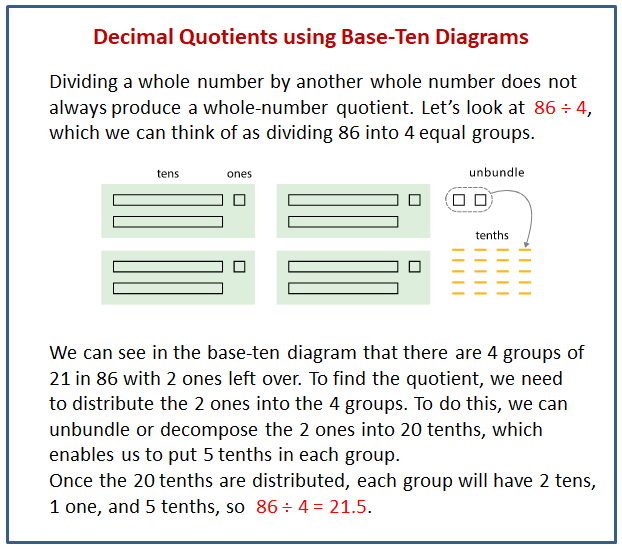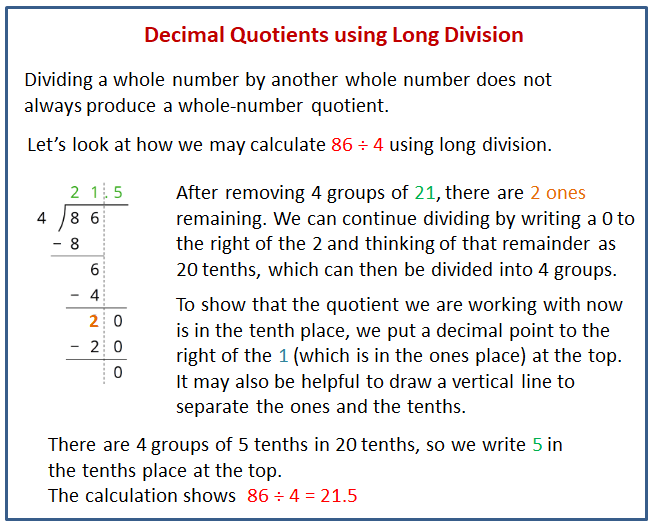Illustrative Mathematics Unit 6.5, Lesson 11: Dividing Numbers that Result in Decimals
Learning Targets:
- I can use long division to find the quotient of two whole numbers when the quotient is not a whole number.
Related Pages
Illustrative Math
Grade 6
Lesson 11: Dividing Numbers that Result in Decimals
Let’s find quotients that are not whole numbers.
Illustrative Math Unit 6.5, Lesson 11 (printable worksheets)
Lesson 11 Summary
The following diagram shows how to use base-ten diagrams to find quotients that are not whole numbers.

The following diagram shows how to use long division to find quotients that are not whole numbers.

Lesson 11.1 Number Talk: Evaluating Quotients
Find the quotients mentally.
400 ÷ 8
80 ÷ 8
16 ÷ 8
498 ÷ 8
Lesson 11.2 Keep Dividing
Here is how Mai used base-ten diagrams to calculate 62 ÷ 5.
She started by representing 62.
She then made 5 groups, each with 1 ten. There was 1 ten left. She unbundled it into 10 ones and distributed the ones across the 5 groups.
Here is her diagram for 62 ÷ 5.
- Discuss these questions with a partner and write down your answers:
a. Mai should have a total of 12 ones, but her diagram shows only 10. Why?
b. She did not originally have tenths, but in her diagram each group has 4 tenths. Why?
c. What value has Mai found for 62 ÷ 5? Explain your reasoning. - Find the quotient of 511 ÷ 5 by drawing base-ten diagrams or by using the partial quotients method. Show your reasoning. If you get stuck, work with your partner to find a solution.
- Four students share a $271 prize from a science competition. How much does each student get if the prize is shared equally? Show your reasoning.
Lesson 11.3 Using Long Division to Calculate Quotients
- Here is how Lin calculated 62 ÷ 5.
Discuss with your partner:
- Lin put a 0 after the remainder of 2. Why? Why does this 0 not change the value of the quotient?
- Lin subtracted 5 groups of 4 from 20. What value does the 4 in the quotient represent?
- What value did Lin find for 62 ÷ 5?
- Use long division to find the value of each expression. Then pause so your teacher can review your work.
a. 126 ÷ 8
b. 90 ÷ 12 - Use long division to show that:
a. 5 ÷ 4, or 5/4, is 1.25
b. 4 ÷ 5, or 4/5, is 0.8
c. 1 ÷ 8, or 1/8, is 0.125
d. 1 ÷ 25, or 1/25, is 0.04 - Noah said we cannot use long division to calculate 10 ÷ 3 because there will always be a remainder.
a. What do you think Noah meant by “there will always be a remainder”?
b. Do you agree with his statement? Why or why not?
Lesson 11 Practice Problems
- Use long division to show that the fraction and decimal in each pair are equal.
a. 3/4 and 0.75
b. 3/20 and 0.06
c. 7/25 and 0.28 - Mai walked 1/8 of a 30-mile walking trail. How many miles did Mai walk? Explain or show your reasoning.
- Use long division to find each quotient. Write your answer as a decimal.
a. 99 ÷ 12
b. 216 ÷ 5
c. 1,988 ÷ 8 - To find the decimal of 9/25, Tyler reasoned: “9/25 is equivalent to 18/20 and to 36/100, so the decimal of 9/25 is 0.36.”
a. Use long division to show that Tyler is correct.
b. Is the decimal of 18/50 also 0.36? Use long division to support your answer. - Complete the calculations so that each shows the correct difference.
- Use the equation 124 · 15 = 1,860 and what you know about fractions, decimals, and place value to explain how to place the decimal point when you compute (1.24) · (0.15)
The Open Up Resources math curriculum is free to download from the Open Up Resources website and is also available from Illustrative Mathematics.
Try the free Mathway calculator and
problem solver below to practice various math topics. Try the given examples, or type in your own
problem and check your answer with the step-by-step explanations.

We welcome your feedback, comments and questions about this site or page. Please submit your feedback or enquiries via our Feedback page.